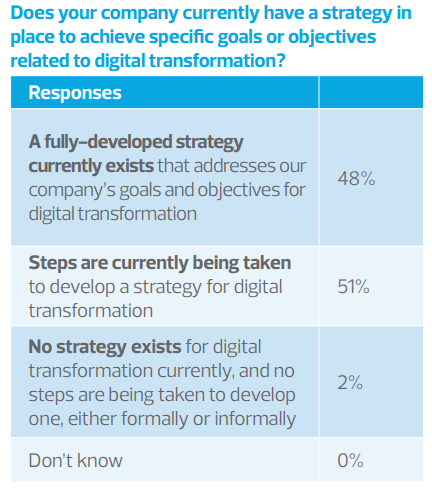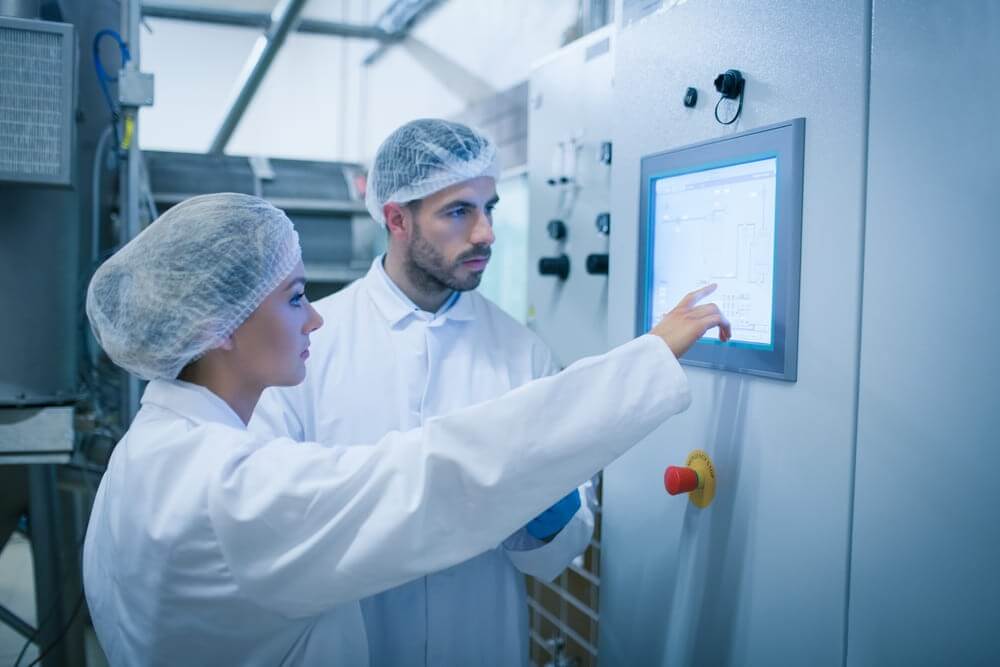When it comes to food, people want to know more about the product and all its ingredients – quality is crucial and the demand is growing. This is when transparency becomes number one on the list, and the most effective way to achieve it is to digitally transform your business.
Nevertheless, some food and beverage manufacturers still believe that digitalization will be of little use in their case. And holding such a mindset will only put a company on a path toward losing their market position. Why would that be a likely outcome? Well, let’s take a deeper dive into digital transformation in the food industry in order to find out why.
We will uncover the most popular misconceptions that concern digital transformation in the food industry. Continue reading if you have any hesitations about your next move towards cutting-edge technologies.
Myth 1: It is too early, so it can wait
The latest technologies still seem a thing of the future to many companies. Food and beverage manufacturers may put more focus on their marketing strategies, new recipes, promotional efforts, and not on digital transformation – yes, all of these factors are undeniably important for a branch, but there is a bigger play at hand here.
Digital transformation is viewed to be a complex concept for most brands, and they put it aside for a special occasion, for someday in the future. But in fact, the time for contemplation and hesitation is over because this day has already come.
In reality…
While you are in the waiting line, tech changes will not get cheaper. The thing is, lots of your competitors have already opted for a digital transformation strategy, and the market has started to change. These changes are irreversible, so you can either start acting now or risk losing your market positions.
Digital transformation is not as complicated as you might think, so if you ever plan to adopt a digital strategy, this is the right time for the very first step.

Myth 2: Everyone has long been undergoing their transformations, so it is too late to start
“Why should I even try if everyone else is so far ahead?” This is a typical question, but it is also in the list of digital transformation myths. Although some of your competitors may have already embarked on their journey, does it necessarily mean they have a well-thought plan on how to implement innovative changes? We have some numbers to prove that this might in fact be the case.
In reality…
Building a digital transformation strategy is indeed a necessity for most food and beverage companies, according to the RSM survey: 94% of them have a digital road map.
However, it does not mean that they have gone through all stages of their digital transformation. Only 48% have a clear and complete tech strategy in their hands, and 51% are currently on the way to finishing it.

Bill Kracunas, RSM management consulting lead, says that “it’s time for companies to move out of the digital transformation planning stage and forward to execution. If organizations aren’t in the planning stage yet, they should be worried. Companies must start putting strategic plans into action.”
It is not too late to build a transformation strategy, but it is late to overthink and be afraid to make the first move towards revolutionary digital planning.
Myth 3: It is only for big enterprises and endless budgets
The word “digital” is not necessarily translated as “tons of money”, but still, lots of brands believe that only big investments can bring a digital transformation to life.
Read also: Why Agile is the Key to Accelerated Digital Transformation?
We do hear lots of stories about global brands, such as Alibaba or Deliveroo, that transform their business processes. But the great thing about digital technologies is that they are flexible and can be used in different ways and for companies of different sizes.
In reality…
It is easier for small and mid-sized F&B companies to adopt their digital transformation initiatives because their production and business structures are more responsive to changes. While larger companies spend time on approving every transformation step, smaller enterprises can already teach employees to use tech innovations in their daily work.
Myth 4: Supply chain tracking is a key digital innovation
We mentioned transparency at the very beginning of this article because it is vital for consumers and their loyalty to a brand: the more open you are, the more trust you can gain. This simple formula makes manufacturers believe that supply chain tracking is the most important innovation on the market.
In reality…
Cloud computing and content management are now weighing heavily on the minds of food and beverage manufacturers – according to RSM, 96% of respondents state that these components are important in their digital strategy. The top five also include marketing automation, CRM, and ERP.

And while marketers mention supply chain tracking, AI, and IoT here and there, respondents of the survey have not implemented these technologies in their everyday work. Subsequently, these three innovations are at the end of the list:

Also, only 10% of respondents are currently using AI and IoT, which makes them a great competitive advantage for F&B manufacturers.
Read also: How to Optimize Supply Chain through IoT, Analytics and Automation
Even though CRM solutions are widely-known on the market, 41% of respondents said they were planning to use a CRM system for the first time. At the same time, the rest of the 59% already have this tech advantage, so this is the first point you should catch up with.
Myth 5: High risks are waiting ahead
Innovative technologies in the food industry are uncharted territory for most manufacturers. The questions usually include “What if..?”, and the digital branch is considered to be extremely risky. But is it really that vague? Luckily, we have some good news for you.
In reality…
Even though companies deal with several integrated tech solutions and a cloud platform at the same time, they are thoroughly analyzed by specialists. Of course, there will always be some brand new solutions adopted only by the brave ones. In this case, a product should be studied for some time and for it to gain its own history and reputation in the industry.
More importantly, enterprises should evaluate potential security breaches. Nowadays, various phishing schemes are not a surprise for any digital innovation, but it is hardly a reason to avoid all the latest technologies altogether.
What you should do is work in collaboration with security experts. Having reliable partners by your side will allow you to feel safe while looking for new ways to upgrade the production process. The risks you potentially have will not be greater than the positive outcomes of using tech innovations.

Myth 6: Digital shifts will bring personnel changes
What will happen to the staff during the digital transformation? This question bothers a lot of business owners. They fear that either the need for senior technicians will lessen or, on the contrary, workers will not cope with the changes.
In reality…
Advanced technologies do not harm any of your employees or production processes – they make them work smoother. There are lots of situations when the human factor may play a negative role, but technologies eliminate this possibility.
Read also: The Future of the Digital Workforce in Manufacturing
Also, workers put aside routine tasks and can focus more on strategic planning or generate ideas to optimize the production process. No machine ever will be able to replace human beings’ creativity.
Myth 7: It is for top management to decide
Another popular myth is that the adoption of digital technologies rests on the top management’s shoulders (CEO), but there is someone else who has a more active role.
In reality…
The chief information officer (CIO) is a boss when it comes to digital transformation. 95% of organizations said that a CIO is a key person responsible for the tech changes in the production process. However, this responsibility is shared with other executives: CFO (60%), and CMO (58%) are in the top three.

This data shows that, on the one hand, digital transformation requires collective work. On the other, there is an opportunity for proactive CFOs to have more responsibility over the revolutionary processes in the company.
According to Bill Kracunas: “With the majority of CFOs playing a critical role in digital transformation, it is vital for those who are not involved to step up and engage themselves in digital transformation. Doing nothing with digital transformation presents a major risk for any CFO in today’s competitive markets”.
Myth 8: Digital tools create a disruptive environment
For some decision-makers, disruptive technologies in the food industry do not promise a happy ending. The fear or hesitation for some may derive from the unwanted creation of an “organized chaos” scenario. The workers’ confusion, a long adaptation period, unorganized processes – this is a real horror show for an F&B manufacturer.
In reality…
There is another meaning for the word “disruptive”: it is also a revolutionary idea in the business world that establishes new norms. It is not well-known among business owners, but it can potentially turn the industry upside down – a solid digital transformation strategy is only the first step.
IoT technologies or cloud solutions do not mean complete chaos for the enterprise, but they are a ground-breaking revelation for every industry. Even if you have to deal with a tool poorly known in the tech world, it only implies longer deployment phases and allocated time and money to train workers.
Read also: Industrial IoT Security: How to Protect Smart Manufacturing
Digital trends bring disruption in the form of fresh thinking, but will not entirely turn down the work processes you have been building for so long.
Leave myths in the past
Myths are good for books and have nothing to do with the real F&B business. If you want to provide customers with high-quality products, forget about digital transformation misconceptions. Now that you know the real stats and explanations, it is time to take a digital strategy seriously.
There is no “too late” or “too early”, high risks can be eliminated, and even small enterprises can join the race. What components will you choose to first implement and how will you proceed? If you are not sure, then let’s answer this question together.
Software experts from Eastern Peak bring high-end technology much closer to an enterprise of any size. Do you want to give it a try? Share your thoughts with our team.
Read also:




